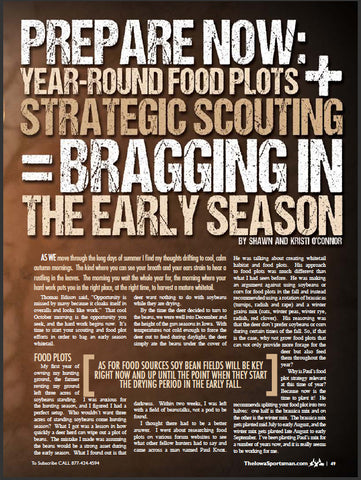Your Preparation Begins Now: Year-Round Food Plots + Strategic Scouting = Bragging Rights this Fall
July 09 2014 – Shawn OConnor
We hope you enjoy our third article in this months Iowa Sportsman magazine, "Prepare Now: Year-Round Food Plots & Strategic Scouting = Bragging In The Early Season".
As we move through the “dog days” of summer, I find my thoughts drifting to cool, calm autumn mornings. The kind where you can see your breath and your ears strain to hear a rustling in the leaves. The morning you wait the whole year for, the morning where your hard work puts you in the right place, at the right time, to harvest a mature whitetail.

Thomas Edison said, “Opportunity is missed by many because it cloaks itself in overalls and looks like work.” That cool November morning is the opportunity you seek, and the hard work begins now. It’s time to start your scouting and food plot efforts.
Food Plots
My first year of owning my hunting ground, the farmer renting my ground left three acres of soybeans standing. I was anxious for the hunting season, and I figured I had a perfect setup. Who wouldn’t want three acres of standing soybeans come hunting season? What I got was a lesson in how quickly a deer herd can wipe out a plot of beans. The mistake I made was assuming the beans would be a strong asset during the early season. What I found out is that deer want nothing to do with soybeans while they are drying down.
By the time the deer decided to turn to the beans, we were well into December and the height of the gun seasons in Iowa. With temperatures not cold enough to force the deer out to feed during daylight, the deer simply ate the beans under the cover of darkness. Within two weeks, I was left with a field of beanstalks, not a pod to be found.
I thought there had to be a better answer. I went about researching food plots and came across a man named Paul Knox. He posted on several websites (IowaWhitetail.com, OutreachOutdoors.com, QDMA.org) under the pseudonyms of Dbltree and LickCreek. He was talking about creating whitetail habitat and food plots. His approach to food plots was much different than what I had seen before. He was making an argument against using soybeans or corn for food plots and instead recommended using a rotation of brassicas (turnips, radish and rape) and a winter grains mix (oats, winter peas, winter rye, radish, red clover). His reasoning was that the deer don’t prefer soybeans or corn, they simply are adaptable and that is what is available to them. So, if that is the case, why not grow food plots that can not only provide more forage for the deer but also feed them throughout the year? In addition, his crop rotation strategy would build your soils and eventually eliminate the need for artificial fertilizer, which obviously saves you quite a bit of money.
Why is Paul’s food plot strategy relevant at this time of year? Because now is the time to plant it! He recommends splitting your food plot into two halves: one half is the brassica mix and on the other is the winter mix. The brassica mix gets planted mid July to early August, and the winter mix gets planted late August to early September. I’ve been planting Paul’s mix for a number of years now, and it is amazing. Go to OutreachOutdoors.com. In their forums section, you will see a forum called “Dbletree’s Corner – Land Stewardship.” You can find information about the brassica mix in the topic called “Brassicas.” Winter mix information is located in “Cereal Grains and Cover Crops.” In addition, there are a number of other forums that are extremely helpful, everything from improving your timber to planting native grasses. Paul’s knowledge sharing has been invaluable for me. Check out what Paul has to offer.
Early Scouting
Your first step is to find where they are feeding. Ignore cornfields. While the deer will live in the cornfields during this time of year, it is not their food source. Bucks are beefing up for the rut, and they can be found feeding in soybean fields in the evening. You can expect to see bachelor groups of bucks feeding together.
Once their velvet sheds, it’s a different story. Their patterns change on a daily basis and their tolerance of one another diminishes. In addition, their food preferences change and they become much more difficult to see out in the open. Late summer is your best opportunity to find a big buck.
1. Scout Long Range
Once you have identified a soybean field where the deer are feeding, there is a good chance you can find them there every evening well before dark. Some guys prefer to get out of their truck and hike in to get a closer look; others simply observe from the road. Just make sure to keep your distance, at least 500 yards away. Be careful not to disturb the deer if you choose to walk.
Dig out your binoculars and get ready for some glassing. A spotting scope comes in handy for this activity. You’ll want to set up before the deer enter the field and remain undetected. Observe where the deer enter the field and their general direction of travel as they feed. Chances are the deer will not enter the field at the same spot each night.
2. Prepare Equipment
At this time you also need to get your trail cameras out, replace their batteries and clear the SD cards. I prefer to synch the time and dates on all my cameras. That way if I have a deer show up on more than one camera, I can learn what direction the deer came from and where he is heading. Test your cameras before setting them out in the woods. The last thing you want is to go pick up your first round of photos and find you have a camera with an issue. You may find you need to invest in a few new cameras. If you haven’t bought a trail camera in a few years, you may want to check out trailcampro.com. They do independent reviews of trail cameras. It’s a good resource to get up to speed on the latest offerings from various companies.
3. Get Close Ups
With trail cameras updated and your long-range scouting completed, we now want to obtain some close-up images of the animals. This will enable us to evaluate the target animals and be able to identify them on the hoof this fall. The most effective way to ensure you get a close-up image is to use a bait station close to the soybean field’s edge. Using corn is preferred but a mineral station can also be utilized. I prefer a corn station. As long as acorns haven’t dropped, I can be certain to get a picture when using corn. The other reason I like a corn station, is that I can be sure there won’t be an issue of lingering remnants once deer season comes around, in case I want to hunt the area.
As the fall season progresses, patterns will change. Place mounts in multiple locations so you can switch up where you place your cameras. I like to use mounts that screw directly into the tree rather than a belt that’s easily seen and obvious to the human eye. September is high season for trail camera theft. Thieves know hunters are setting out their trail cameras, getting ready for the season, but they’re not hunting yet, so less chance of being caught. The weather is more temperate and the woods foliage is not as thick as in the summer months, which makes it a perfect opportunity for trespassers to search out your cameras and snatch them. My cameras where stolen in September a few years ago. Fortunately I had other cameras the thief missed and they captured an image of him. That’s when I started camouflaging my cameras with CAMBUSH, and I haven’t had a problem since.
Deer will travel where they feel comfortable. They also avoid areas that have brought them anxiety or alarm. Be careful of where you place your trail cameras and how you camouflage them from sight so that the deer have a harder time detecting their unnatural boxy shape. Treat every entry and exit from your camera locations as you would an actual hunt. Control your scent and be mindful of where you travel and your visibility.
4. Uncover Patterns with Trail Cameras
Take all those images you’ve been collecting and study them! This can be tedious, but those images are worth a thousand words and can teach you a lot about your shooters.
 I’ve always been told to keep a journal and categorize my photos so I can pinpoint my shooters, keep tabs on their activity and patterns, give them unique names, and then recognize changes in their behavior. I’m not always good at doing what I’ve been told. Keeping a diary is not one of my strong points. Luckily, I discovered software that will do all that work for me. Check out a few of these online applications and compare them yourself. I’ve been using one from DeerLab.com.
I’ve always been told to keep a journal and categorize my photos so I can pinpoint my shooters, keep tabs on their activity and patterns, give them unique names, and then recognize changes in their behavior. I’m not always good at doing what I’ve been told. Keeping a diary is not one of my strong points. Luckily, I discovered software that will do all that work for me. Check out a few of these online applications and compare them yourself. I’ve been using one from DeerLab.com.
An app like this will allow you to filter your trail camera photos by date ranges, weather conditions, moon phases and more. It basically gives you weather data trail cameras currently can't provide and allows you to observe how weather conditions impact deer movement on your property.
Another nice feature is the ability to pattern unique bucks. Using your trail camera photos, the software will tell you what cameras a specific buck is hitting and the times he is hitting it. All of this can be filtered by date ranges, which is especially helpful as hunting pressure can change movements during different times of the year.
While none of these efforts can guarantee success, using a combination of year-round food plots and strategic scouting can definitely increase your odds in hunting the right stand at the right time. I can hear the rustle of leaves now…
Shawn and Kristi O'Connor are the founders of CAMBUSH Camo for trail cameras. Shawn is an avid trail camera user and deer hunter.


0 comments